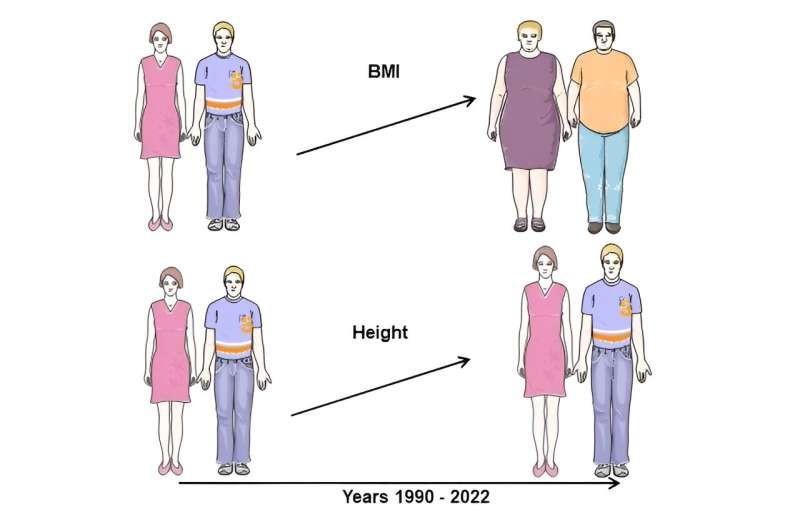This article has been reviewed according to Science X's editorial process and policies. Editors have highlighted the following attributes while ensuring the content's credibility:
fact-checked
peer-reviewed publication
proofread
Data suggest cardiometabolic risk of a higher BMI may be underestimated in taller populations worldwide

Since 1990, the prevalence of obesity among children and adolescents (determined by the body mass index, BMI) has increased four-fold and obesity rates among adults have more than doubled.
It is strongly assumed that this dynamic in the obesity epidemic will also increase the risk of BMI-associated diseases, particularly cardiovascular diseases and type 2 diabetes.
DZD researchers Norbert Stefan, Matthias Schulze and colleagues hypothesized that the increase in height that occurred in most countries worldwide during the past decades, might impact on this BMI-associated cardiometabolic risk.
In their research article, titled "Impact of higher BMI on cardiometabolic risk: does height matter?" and published in The Lancet Diabetes & Endocrinology, they provide novel data showing that the increase of BMI fat mass and the risk of type 2 diabetes is increased in taller people. Based on their findings, they hypothesize that the cardiometabolic risk of a higher BMI may be underestimated in taller grown populations worldwide.
Related to the World Obesity Day 2024 (March 4), The Lancet published a study conducted by the NCD Risk Factor Collaboration (NCD-RisC), in collaboration with the World Health Organization (WHO), reporting weight and height measurements from 222 million people in 200 countries and territories.
In that study, BMI, calculated from measurements of weight and height, was used to investigate how obesity and underweight have changed worldwide from 1990 to 2022. They found that over one billion people worldwide are currently living with obesity (defined as BMI ≥30 kg/m2 in adults).
Considering the very high burden of disease related to high BMI (e.g. in 2015, 4 million deaths, representing 7.1% of all deaths; cardiovascular disease was the leading cause and diabetes the second leading cause of death related to high BMI), an increase in BMI-associated diseases is expected from 1990 to 2022.
However, Norbert Stefan (Helmholtz Munich and the University of Tübingen), Matthias Schulze (German Institute of Human Nutrition Potsdam-Rehbrücke) and colleagues, who have studied the impact of height on the risk of cardiometabolic diseases, argue that such calculations should account for other important secular trends in anthropometry, particularly height, which may impact the interpretation of BMI as a measure of body fatness.
Stefan states, "BMI is only an approximation of fat mass and BMI is not necessarily independent of height. Importantly, from 1985 to 2020 mean height in children and adolescents increased in most countries worldwide."
Schulze adds, "In adolescents and young adults, moderate-to large gains in height alongside small or no increases in BMI observed from 1985 to 2019 in some countries is considered a healthy trajectory. However, it is unknown whether increased height potentially modifies the meaningfulness of BMI as a measure of body fatness and cardiometabolic risk."
Analyzing data from 972 subjects who participated in the Tübingen Diabetes Family Study the authors found that the positive relationship between BMI and precisely measured total body fat mass became stronger with increasing height, both in women and men. This relationship was not affected by age or upper- and lower-body skeletal volume.
Then the authors analyzed data from 25,393 participants of the European Prospective Investigation into Cancer and Nutrition (EPIC)-Potsdam study. They found that the hazard ratios, adjusted for confounders selected based on a causal model, for a difference in BMI by 5 kg/m2 for type 2 diabetes increased gradually from 1. 58 (95% CI 1.12–2.23) in the lowest height category (≤150 cm) to 2.85 (95% CI 2.37–3.42) in the highest height category (>180 cm).
The authors conclude from their findings that BMI better reflects fat mass and, thus, cardiometabolic risk in taller compared to shorter people. They also hypothesize that, for a similar BMI, present adults may face a larger BMI-associated health burden compared to historical populations, because they are on average taller.
Therefore, it is important to account for the increase in height during the last decades to better estimate the obesity-associated burden of cardiometabolic diseases in the future.
More information: Norbert Stefan et al, Impact of higher BMI on cardiometabolic risk: does height matter?, The Lancet Diabetes & Endocrinology (2024). DOI: 10.1016/S2213-8587(24)00164-5





















